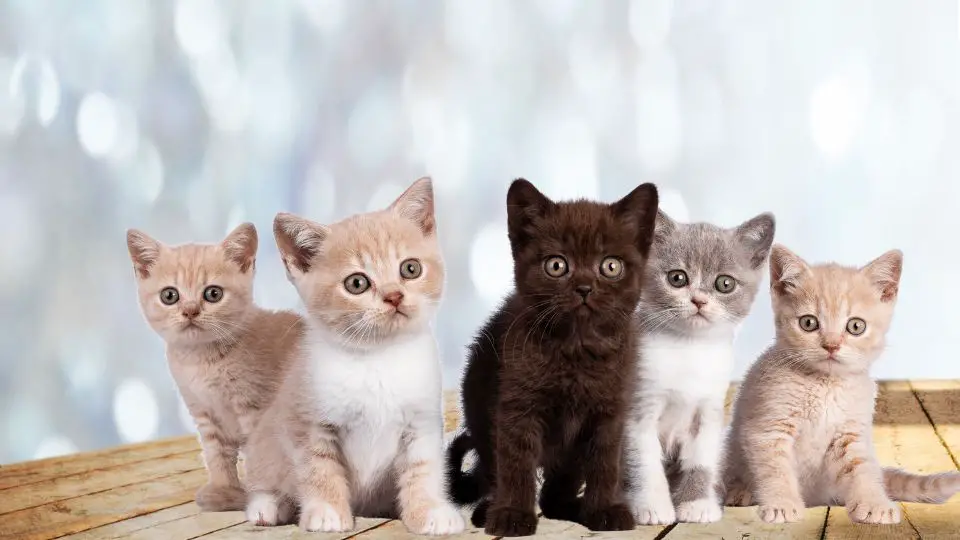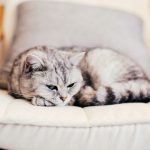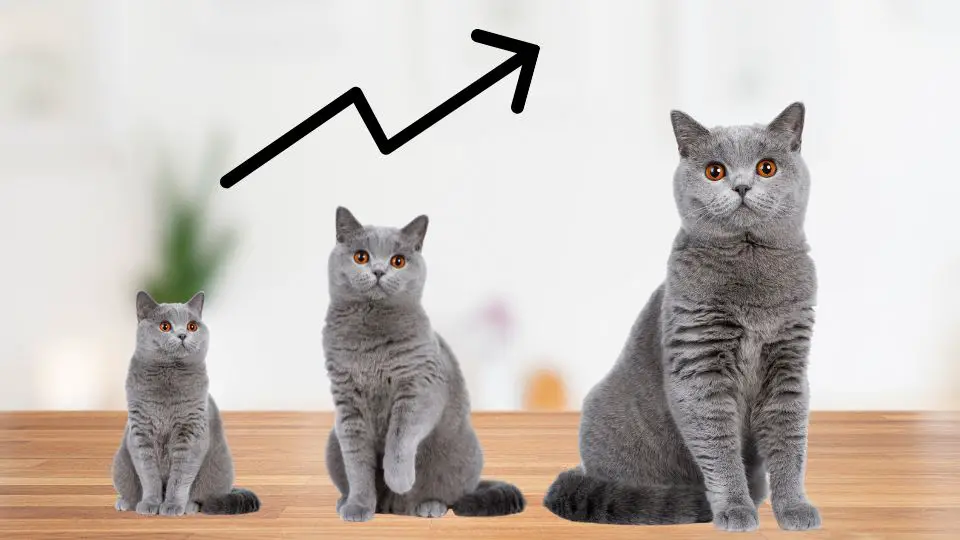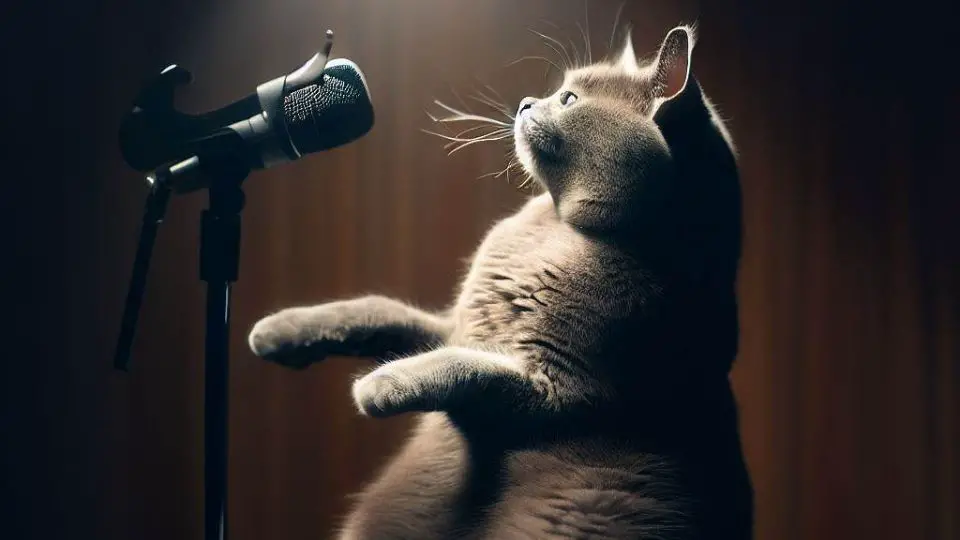The British Shorthair breed is known for its charm, beauty, and distinctive appearance. With a wide range of coat colors, patterns, and traits, British Shorthairs come in various types that captivate cat lovers around the world.
In this article, we will explore the different types of British Shorthair cats, highlighting their unique characteristics, appearances, and distinguishing features. Whether you’re a fan of the traditional solid-colored British Shorthairs or fascinated by the rare and exotic variations, this guide will provide insights into the diverse world of British Shorthair types.
Traditional British Shorthair
The Traditional British Shorthair is a medium to large-sized cat with a sturdy and muscular build. They have a round face with full cheeks and a well-developed chin. Their eyes are large and round, typically ranging in color from gold to copper. One of their defining features is their dense and plush coat, which is short, dense, and crisp to the touch. They come in a variety of solid colors, including blue, black, white, cream, and more.
This breed is known for its adorable round body shape, often described as “cobby.” They have a broad chest and a compact, rounded appearance. Their legs are short and thick, supporting their solid frame. The Traditional British Shorthair has a sweet and gentle expression that adds to its overall charm.
History and Origin
The Traditional British Shorthair has a rich history that dates back centuries. Its origins can be traced back to the domestic cats of Rome, which were brought to Britain by the Romans. Over time, these cats interbred with local British cats, resulting in the development of the British Shorthair breed as we know it today.
During the early years of the breed, British Shorthairs were primarily working cats, valued for their hunting abilities and mousing skills. They were commonly found in British households and farms, where they served as efficient rodent control. Their sturdy build and calm temperament made them excellent companions and reliable working cats.
In the late 19th century, cat shows gained popularity, and breeders started selectively breeding British Shorthairs to enhance their desirable traits. This led to the development of specific color variations and the refinement of their physical characteristics. The breed’s popularity continued to grow, and today, the Traditional British Shorthair is cherished for its charming appearance and delightful personality.
Colorpoint British Shorthair
The Colorpoint British Shorthair shares many physical characteristics with the traditional British Shorthair breed. They have a sturdy and muscular build with a rounded face, full cheeks, and large round eyes. However, what sets them apart is their distinctive coat color and pattern.
The Colorpoint British Shorthair has a pointed coloration pattern, which means that their body is lighter in color while their extremities, such as their ears, face, paws, and tail, are darker. This gives them an elegant and eye-catching appearance. The body color can range from pale cream to warm beige or fawn, while the points are typically a deeper shade of the same color, such as chocolate, lilac, or blue.
Color Variations
The Colorpoint British Shorthair comes in a variety of beautiful color variations. Some of the most common colorpoint patterns include:
- Seal Point: This color variation features a dark brown or black color on the points.
- Blue Point: The points in this variation are a pale bluish-gray color.
- Chocolate Point: The points are a rich, warm chocolate brown.
- Lilac Point: The points in this variation have a pale, soft grayish-pink hue.
These color variations, along with the breed’s dense and plush coat, create a stunning contrast that adds to the Colorpoint British Shorthair’s allure.
Silver and Golden Tipped British Shorthair
The Silver and Golden Tipped British Shorthair shares many physical characteristics with the traditional British Shorthair breed. They have a sturdy and muscular build with a round face, full cheeks, and large round eyes. However, what sets them apart is their exquisite coat and distinctive tipping.
Coat Colors and Patterns
- Silver Tipped: The Silver Tipped British Shorthair has a silver-tipped coat, also known as chinchilla. Their coat is predominantly white, with the tips of each hair being black. This creates a sparkling silver effect and gives them a regal appearance.
- Golden Tipped: The Golden Tipped British Shorthair has a similar coat pattern to the Silver Tipped, but with a golden hue instead of silver. Their coat is predominantly white, with the tips of each hair being a warm shade of golden brown.
These coat colors and patterns give the Silver and Golden Tipped British Shorthair a unique and glamorous look. Their plush, dense coat is often described as “shimmering” due to the contrast between the light-colored base and the dark-colored tipping. This striking coat, combined with their muscular build and round face, creates a cat that truly stands out.
Tabby British Shorthair
The Tabby British Shorthair shares many physical characteristics with the traditional British Shorthair breed. They have a sturdy and muscular build with a round face, full cheeks, and large round eyes. However, what sets them apart is their beautiful tabby coat.
Tabby Patterns
- Classic Tabby: The Classic Tabby pattern is characterized by bold, swirling patterns on the cat’s coat. This pattern features distinct dark stripes that run along the body, forming a “bullseye” pattern on the cat’s sides. The Classic Tabby pattern is often referred to as a “marbled” or “blotched” pattern.
- Mackerel Tabby: The Mackerel Tabby pattern is characterized by narrow, straight stripes that run vertically down the cat’s body. These stripes resemble fishbones, hence the name “mackerel.” The Mackerel Tabby pattern creates a sleek and elegant appearance.
- Spotted Tabby: The Spotted Tabby pattern features spots instead of stripes. These spots can vary in size and are scattered across the cat’s coat. The Spotted Tabby pattern gives the cat a playful and lively appearance.
- Ticked Tabby: The Ticked Tabby pattern is characterized by fine, agouti hairs that create a speckled or salt-and-pepper appearance on the cat’s coat. This pattern is often seen in Abyssinian cats and can give the Tabby British Shorthair a unique and refined look.
These tabby patterns, whether it’s the bold Classic Tabby, the sleek Mackerel Tabby, the playful Spotted Tabby, or the refined Ticked Tabby, contribute to the Tabby British Shorthair’s charm and individuality. The combination of these beautiful patterns with the British Shorthair’s strong physique and affectionate nature makes the Tabby British Shorthair a beloved breed among cat enthusiasts.
Tortoiseshell and Calico British Shorthair
The Tortoiseshell and Calico British Shorthair cats possess the same physical characteristics as the traditional British Shorthair breed. They have a solid and muscular build, round faces with full cheeks, and large, expressive eyes. What sets them apart is their eye-catching coat patterns and vibrant colors.
Coat Patterns and Colors
- Tortoiseshell: The Tortoiseshell pattern consists of a mix of two colors – black and red or shades of orange. The coat features a marbled or patched appearance, with the colors blending together in a unique and intricate pattern. Tortoiseshell cats may also have small spots of white known as “tortie with white” or “caliby.”
- Calico: Calico cats, also referred to as tri-color or tortie-and-white, have a three-color coat pattern consisting of white, black, and orange or red patches. These patches are distinct and can be evenly distributed or have a more random arrangement on the cat’s coat. Calico cats are known for their striking and vibrant appearance.
Both Tortoiseshell and Calico British Shorthair cats showcase a wide range of colors within their patterns. The coat colors can include different shades of black, red, orange, cream, and white, creating a visually stunning and unique combination.
The Tortoiseshell and Calico British Shorthair cats are not only admired for their captivating coat patterns but also for their affectionate and friendly personalities. They are known to be independent yet social cats, often forming strong bonds with their owners.
Blue British Shorthair
The Blue British Shorthair has a solid and muscular build with a rounded appearance. It features a broad chest, strong legs, and a thick, dense coat that gives it a plush teddy bear-like appearance. The most striking feature of the Blue British Shorthair is its coat color, which is a soft and mesmerizing shade of blue-gray. The coat is dense and stands away from the body, emphasizing the cat’s robust physique.
The Blue British Shorthair has large round eyes that range in color from copper to gold, adding to its endearing and expressive look. Its face is characterized by full cheeks and a gentle expression, giving it a sweet and friendly appearance.
Unique Features
One of the unique features of the Blue British Shorthair is its coat color. The blue-gray hue is specific to this breed and is often described as a slate or steel blue. The dense and plush coat gives the Blue British Shorthair a luxurious and cuddly feel, making it a delight to pet and snuggle.
In addition to its stunning appearance, the Blue British Shorthair is known for its calm and laid-back personality. These cats are generally easygoing, affectionate, and enjoy spending quality time with their human companions. They are known to be great companions and are well-suited for families and individuals alike.
The Blue British Shorthair is a breed that brings elegance, charm, and serenity to any home. Whether you’re captivated by its striking blue-gray coat or drawn to its friendly and relaxed nature, the Blue British Shorthair is sure to win your heart.
Solid and Self British Shorthair
The Solid and Self British Shorthair has a robust and muscular build with a compact and rounded body. It features a broad chest, strong legs, and a well-balanced physique. The most notable feature of the Solid and Self British Shorthair is its solid coat color, which means the entire coat is composed of one color without any markings, patterns, or tabby stripes. This gives the cat a sleek and sophisticated appearance.
The head of the Solid and Self British Shorthair is round and wide, with full cheeks and large round eyes that can come in various colors depending on the coat color. The ears are medium-sized and set apart, adding to the cat’s adorable and expressive look.
Coat Colors
The Solid and Self British Shorthair comes in a wide range of coat colors, allowing for a diverse and stunning array of choices. Some of the most common coat colors seen in the Solid and Self British Shorthair include:
- Black: A solid and lustrous black coat that exudes elegance and mystery.
- Blue: A soft and beautiful shade of blue-gray that gives the cat a regal and enchanting appearance.
- Cream: A warm and creamy coat color that showcases the breed’s luxurious and plush coat.
- White: A pure and pristine white coat that highlights the cat’s striking features and showcases its elegance.
These are just a few examples of the coat colors found in the Solid and Self British Shorthair. Each color brings its own unique charm and adds to the overall beauty of the breed.
Cinnamon and Fawn British Shorthair
The Cinnamon and Fawn British Shorthair shares the same robust and muscular build as other British Shorthair cats. They have a solid and compact body with a broad chest, strong legs, and a well-balanced physique. What sets them apart is their beautiful coat colors.
The Cinnamon British Shorthair has a warm and rich cinnamon-colored coat that is deep and vibrant. It showcases a reddish-brown hue reminiscent of cinnamon spice, giving the cat a unique and striking appearance. The coat is dense and plush, further accentuating the cat’s solid and powerful build.
On the other hand, the Fawn British Shorthair boasts a delicate and light fawn-colored coat. This color variation is characterized by its soft and pale beige or tan shade, which exudes elegance and charm. The coat has a subtle and understated beauty that perfectly complements the cat’s sturdy and compact physique.
Rare Color Variations
The Cinnamon and Fawn British Shorthair are considered rare color variations within the breed. Their distinctive coat colors are not commonly seen, making them highly sought after by cat enthusiasts and collectors.
The Cinnamon and Fawn British Shorthair add diversity and uniqueness to the already diverse world of British Shorthair cats. Their rare coat colors make them stand out from the crowd and become a captivating focal point wherever they go.
Longhair British Shorthair
The Longhair British Shorthair, also known as the British Longhair, shares the same sturdy and robust build as its short-haired counterpart. It has a well-rounded and muscular body with a broad chest and strong legs. What distinguishes the Longhair British Shorthair is its luxurious and flowing coat.
The coat of the Longhair British Shorthair is long, dense, and plush, giving the cat an elegant and regal appearance. It features a dense undercoat and a longer outer coat that gives it a voluminous and majestic look. The coat is known for its soft and silky texture, inviting endless strokes and caresses.
Differences from the Traditional British Shorthair
The key difference between the Longhair British Shorthair and the traditional British Shorthair lies in their coat length. While the traditional British Shorthair has a short and dense coat, the Longhair British Shorthair boasts a long and flowing coat that requires more grooming and maintenance.
Due to their longer fur, Longhair British Shorthairs often require regular brushing to prevent matting and tangles. Their grooming routine includes thorough brushing sessions to keep their coat in optimal condition and minimize shedding. Additionally, occasional bathing may be necessary to maintain their coat’s cleanliness and freshness.
In terms of temperament and personality, the Longhair British Shorthair shares the same delightful qualities as the traditional breed. They are known for their calm and gentle nature, making them wonderful companions for families and individuals alike. Their affectionate and laid-back demeanor adds to their charm, making them a joy to have around.
FAQ
How many types of British Shorthair are there?
The British Shorthair breed has various types that are distinguished by their different coat colors, patterns, and traits. Some of the common types include the Traditional British Shorthair, Colorpoint British Shorthair, Tabby British Shorthair, Silver and Golden Tipped British Shorthair, Tortoiseshell and Calico British Shorthair, Blue British Shorthair, Solid and Self British Shorthair, Cinnamon and Fawn British Shorthair, Longhair British Shorthair, and the rare varieties that showcase unique characteristics.
How rare is a British Shorthair?
The rarity of British Shorthair cats depends on the specific type or variety. While the Traditional British Shorthair is more widely available, some of the rarer variations with unique colors, patterns, or traits may be more difficult to find. Breeding programs and specialty breeders focus on preserving and promoting these rare varieties, which may make them less common in comparison to the more popular ones.
What is a Harlequin British Shorthair?
A Harlequin British Shorthair refers to a specific coat pattern where the cat has a white base coat with well-defined patches of another color or pattern, such as black, blue, or silver. The patches can be irregularly shaped and are usually distinct and contrasting in color. The Harlequin pattern creates a visually striking appearance, adding to the uniqueness of the British Shorthair breed.
What are the rarest British Shorthair colors?
The rarest colors in British Shorthair cats can vary depending on the specific breeding program and availability. Some of the rare colors include Lilac, Chocolate, Cinnamon, Fawn, and the Dilute versions of these colors. These rare colors are highly sought after by enthusiasts and may have limited availability due to the specific genetic combinations required to produce them.
Conclusion
In conclusion, the British Shorthair breed encompasses a captivating array of types, each with its own distinctive traits and allure. From the elegant and regal Traditional British Shorthairs to the strikingly patterned Tabby British Shorthairs, and the rare and unique varieties, there is a British Shorthair type to suit every cat lover’s preferences.
Whether you are drawn to their calm and independent nature, their captivating coat colors and patterns, or their charming personalities, British Shorthairs never fail to enchant with their beauty and charm. Whichever type you choose, a British Shorthair will undoubtedly bring joy, companionship, and a touch of elegance to your home.







